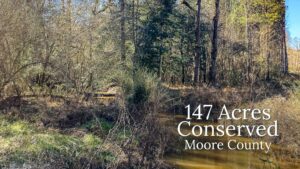
by Crystal Cockman
May 19, 2016
Land Trusts now have a new set of data to help them in their mission to conserve the most important lands in the face of changing climactic conditions. The Nature Conservancy in consultation with a growing network of scientists and researchers has developed what is called “resilience science.” This information is meant to assist with conserving habitats that will be important in the face of an uncertain future under climate change conditions.
Plants and animals need appropriate habitats in order to survive, but we cannot predict habitat shifts under climate change, so we must locate areas that best serve species needs. The best way to do so is to protect “a network of resilient sites that support the full range of biological diversity under changing conditions.”* The term resilience is meant in this situation that land can bounce back from disturbance and continue to support diverse forms of life. Resilience is based on three elements: landform complexity, connectivity, and geology.
Landforms are significant because they are important in determining temperature and moisture and, as a result, the impacts of disturbances. The more slopes, valleys and cliffs in an area the more microclimates there are for species to choose from. These different climates in small areas provide species the ability to move locally to adapt, reducing the need to move larger distances.
Connectivity, or wildlife corridors of protected lands, is important because species will likely need to move upslope or north in the face of warmer climates. Local connectivity is perhaps even more important because it is the amount of natural cover surrounding a site that allows species to access microclimates mentioned above.
The last element is geology. This is important because by protecting a range of geology, such as limestone, granite, and shale, at various elevations, we protect the range of habitat types found on those different areas, known as geophysical settings. By protecting sites that have diverse landforms and local connectivity with a range of geology and elevation, the thought is that one can preserve a wide range of habitats and thus a wide range of biological diversity. (See Figure 1).
By focusing on the physical characteristics of the land rather than specific species means that we don’t have to try and predict how changes in temperature or moisture will affect species movement. Protecting the most complex and connected geophysical settings in the Southeast is the best chance at preserving a suite of habitats that benefit the most species.
The Open Space Institute has developed a grant program called the Southeast Resilience Landscapes Fund. This fund is capitalized with a grant from the Doris Duke Charitable Foundation and provides grants and loans to land protection projects within the Southern Cumberlands Focus Area in Alabama, Georgia and Tennessee; the Southern Blue Ridge Focus Area in North Carolina, South Carolina and Tennesee; and the Greater Pee Dee River Focus Area in North Carolina and South Carolina. The LandTrust for Central NC has obtained two grants through this fund in 2015 to protect important lands surrounding the Uwharrie National Forest.
The Southeast has some of the richest and most diverse landscapes on Earth, housing 10% of the world’s biodiversity and 10% of the world’s wood products. It is important to protect what we can for the future resiliency of our region.
*Information for this article is largely taken from a publication by the Open Space Institute called “Taking the Lead on Climate Change, Land Trusts can safeguard the Southeast’s Natural Heritage.” http://www.osiny.org/site/DocServer/Taking_the_Lead_on_Climate_Change_White_Paper_SE.pdf?docID=15241